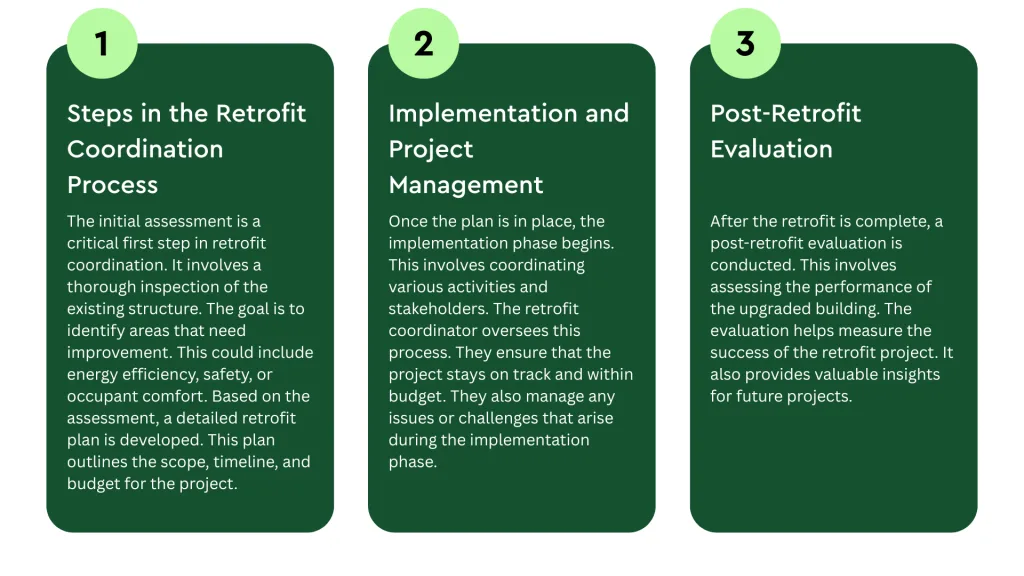
A Comprehensive Guide to Retrofit Coordination
In the realm of construction management, retrofit coordination holds a pivotal role. It's a process that breathes new life into existing structures. The role of a retrofit coordinator is to enhance energy efficiency, extending the lifespan of buildings, and contributing to changing lives for the better.
This guide aims to provide a comprehensive understanding of retrofit coordination. It’s designed for construction managers, project coordinators, architects, engineers, and other professionals involved in building renovation. We’ll delve into the steps involved in the retrofit coordination process. We’ll also explore the challenges faced during retrofit projects and how to overcome them. Whether you’re a seasoned professional or new to the field, this guide will equip you with the knowledge and best practices for successful retrofit coordination. Let’s embark on this journey to sustainable construction management.
Understanding Retrofit Coordination, And The Role
Retrofit coordination is a specialized field within construction management. It involves the planning, implementation, and management of retrofit projects.
Retrofit projects aim to upgrade existing buildings. The goal is to improve their performance, safety, and comfort.
Key aspects of retrofit coordination include:
- Assessment of the existing structure
- Planning for energy efficiency and sustainability
- Managing costs and risks
- Ensuring compliance with building codes and regulations
Coordinating with multiple stakeholders
A retrofit coordinator is the linchpin of a retrofit project. They oversee the entire process, from initial assessment to post-retrofit evaluation. Their role involves liaising with various stakeholders. These include building owners, architects, engineers, contractors, and suppliers. The retrofit coordinator ensures that the project meets its goals. They balance cost-effectiveness, energy efficiency, and occupant comfort.
The Importance of Retrofitting in Modern Construction
Retrofitting is crucial in today’s construction landscape. It’s a key strategy for extending the lifespan of existing buildings. Retrofitting also contributes to energy efficiency and sustainability. It helps reduce the carbon footprint of buildings. Moreover, retrofitting can enhance the value and marketability of a property. It’s a win-win for building owners and the environment.
The retrofit coordination process involves several key steps. Each step requires careful planning and execution. The process begins with an initial assessment of the existing structure. This is followed by detailed planning and design. The next step is the implementation of the retrofit plan. This involves project management and coordination of various activities. Finally, the process concludes with a post-retrofit evaluation. This helps measure the success of the project.
The steps in the retrofit coordination process include:
- Initial assessment
- Planning and design
- Implementation
- Post-retrofit evaluation

Overcoming Challenges in Retrofit Projects
Retrofit projects can present several challenges. These can range from technical issues to stakeholder disagreements. A key to overcoming these challenges is effective project management. This involves clear communication, risk management, and cost control. By anticipating potential issues and planning for them, many challenges can be mitigated or avoided altogether.
Communication and Stakeholder Engagement
Effective communication is crucial in retrofit projects. It ensures all stakeholders are on the same page. Regular meetings, updates, and clear documentation can help facilitate this. Stakeholder engagement is also key to the success of the project.
Managing Costs and Risks
Cost and risk management are other important aspects of retrofit coordination. Detailed budgeting and contingency planning can help control costs. Risk assessments and safety protocols can mitigate potential risks. This ensures the project is completed safely and within budget.
Looking for support with Retrofit Coordination?
The Role of Technology in Retrofit Coordination
Technology plays a significant role in retrofit coordination. It aids in planning, implementation, and evaluation of retrofit projects. One such technology is Building Information Modelling (BIM). BIM allows for detailed 3D modelling of the building. This helps in identifying potential issues and planning the retrofit accordingly. Another important aspect is the use of software for project management. This helps in tracking progress, managing costs, and ensuring timely completion of the project.
Building Information Modelling (BIM) and Energy Audits
Building Information Modelling (BIM) is a powerful tool in retrofit coordination. It provides a 3D model of the building, aiding in planning and implementation. Energy audits are another important aspect. They help in identifying areas of energy inefficiency. This information is crucial in planning the retrofit to improve energy efficiency. Both BIM and energy audits contribute significantly to the success of retrofit projects. They help in planning, implementation, and evaluation of the retrofit.